The healthy watermelon provides refreshment on hot summer days. We show how you can grow the watermelon in your own garden.

[Photo: TOONGNA ONLINE/ Shutterstock.com]
watermelons (Citrullus lanatus) are considered exotic fruits, mostly imported from distant countries. In fact, the origin of the green-pink fruit is West Africa, so the lush melon plants feel happiest when the temperature is appropriate. Nevertheless, cultivation is also possible in our latitudes with the right tips and tricks. We will show you how to grow the melons yourself.
contents
-
Planting watermelon: when, how to proceed and where
- Plant watermelon: the right location
- Planting watermelons: the right time
- Planting a watermelon: the procedure
- Plant a watermelon in a pot
-
Growing watermelons: buy plants or propagate yourself?
- Grow watermelons yourself
- Buy watermelon plants
- Watermelon: Varieties, Species and Varieties
-
Growing watermelons: the right care
- Watering watermelons properly
- Fertilize watermelons
- Harvesting watermelons: when are they ripe?
- Storing watermelons
Planting watermelon: when, how to proceed and where
Although the watermelon is a pumpkin plant (Cucurbitaceae), it is much more sensitive to cold than cucumbers or pumpkins. You should therefore pay attention to a few points when choosing the location and the right time.
Plant watermelon: the right location
Melon plants are generally demanding in terms of location. Therefore, pay attention to the following aspects: Watermelons prefer sandy and humus-rich soil. Soil that is too heavy hinders root penetration and tends to accumulate water. We also recommend preparing the bed with plenty of compost before planting out so that the watermelon plant gets enough nutrients. In addition to the right soil, a warm, sunny and wind-protected place is advantageous for melons. The south wall of the house or the warm climate in the greenhouse, for example, offer optimal conditions.
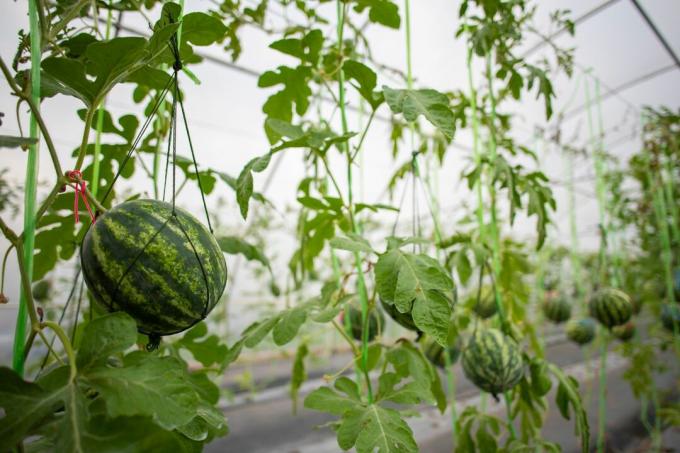
When choosing a location, pay attention to these aspects:
- Light and humus-rich soil (soil that is too heavy is unsuitable)
- Warm, sunny and wind-protected place
- Optimally in the greenhouse or on a south wall
Planting watermelons: the right time
Watermelons are plants that need a lot of warmth - so planting them out too early can be fatal! Plant young plants outdoors at the end of May to early June at the earliest, in the greenhouse you can start as early as April. It should always be noted that melons are already sensitive to temperatures below 12 °C.

Planting a watermelon: the procedure
The actual planting of the exotic is relatively easy: place the young plants with a sufficient distance in the bed. Always calculate 1 to 2 square meters per plant so that it has enough space to grow.
Plant a watermelon in a pot
A good alternative to growing melons in a bed is planting them in a pot. In this way, you save space in the bed and still don't have to do without the delicious fruits. When growing watermelons in pots, you should note that although the soil warms up faster than outdoors, it also dries out faster. Therefore, choose the largest possible pot and water frequently. It is also an advantage not to place the plant in the blazing sun, because the soil dries out faster there.
Growing watermelons: buy plants or propagate yourself?
Before you start growing watermelons in spring, many people ask themselves the question: buy a melon plant or grow it yourself? We present both options and show you the advantages and disadvantages.
Grow watermelons yourself
Preparing your own watermelon plants is not a problem and the germination rate is high. To do this, plant one seed per seed pot about 1 to 2 cm deep from March to April. A temperature of over 18 °C is necessary for germination, ideally this is between 22 and 24 °C. The window sill is a very good place for cultivation and the first seedlings can already be seen after 5 to 10 days. As soon as the first leaves appear, the young plants can then be transplanted into larger pots. When repotting, be sure not to damage the roots, as watermelons are very sensitive to injury.

When propagating watermelons, keep these tips in mind:
- Sow from March to April at a depth of 1 – 2 cm
- Location on a windowsill or in a mini greenhouse (min. 18°C)
- First seedlings appear after 5-10 days
- Transplant into larger pots as soon as the first leaves appear
Buy watermelon plants
A less time-consuming method than growing seeds is to buy young plants that have already been grown. You can buy these in the garden center from May to June and then plant them outdoors in the same way. An advantage of these young plants is that they are often grafted on pumpkin rootstock and are therefore less susceptible to root diseases. In principle, the purchase is also a question of cost, as large quantities of early plants are significantly more expensive than seeds.
Watermelon: Varieties, Species and Varieties
When people hear the word watermelon, many people think of the large green fruit with the pink flesh – but in fact the species is very diverse. The varieties sometimes differ greatly in appearance, but they are all the same species Citrullus lanatus. There are basically two variations of watermelons:
1. Citrullus lanatus var. lanate: This variation includes the cultivated watermelons that are grown commercially around the world. This is the classic watermelon that everyone knows.
2. Citrullus lanatus var. citroides: This wild form of the melon grows mainly in Africa and is also known as the Tsamma melon. The flesh of this variety is not pink, but yellowish to light green.
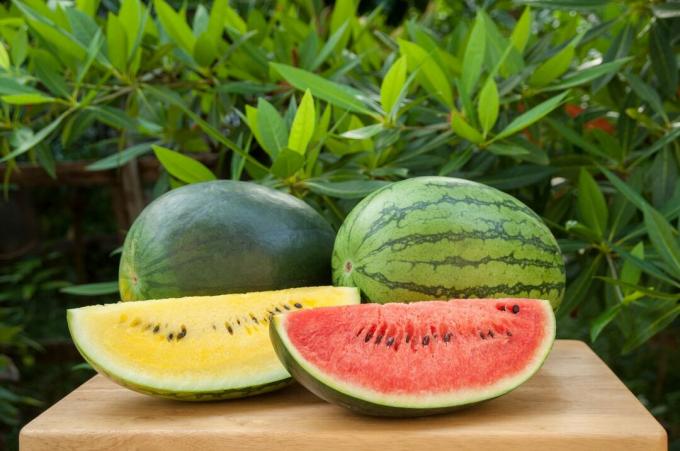
The varieties for cultivation in this country mainly belong to the variation Citrullus lanatus var. Lanatus. Some of these can also grow in the cooler climate of Germany.
We introduce some popular ones watermelonsslocate below, a larger list can be found here.
Bush Sugar Baby
- New breed derived from Sugar Baby
- Early ripening with smaller fruits: 2 - 4 kg (1 - 2 fruits per plant)
- Red flesh with a dark skin
- Plant remains quite compact (1 sqm per plant)
Crimson Sweet
- Widespread and popular variety worldwide
- Fruits are oval and light green; high fruit weight: 5 – 8 kg
- Aromatic light red pulp
- Good resistance to leaf blight and other fungal diseases
- 1.5 - 2 sqm per plant
red star
- Dark skin and deep red flesh; high sugar content
- Fruit size: 6 – 8kg
- The variety is suitable for cultivation in temperate climates and should not be cultivated in harsh areas due to the somewhat longer ripening period
- 1.5 sqm per plant
Growing watermelons: the right care
Once the watermelon plant has become well accustomed to its location in the garden, its growth can hardly be slowed down. However, there are a few things you should keep in mind to ensure that the plant is adequately supplied with water and nutrients.
Watering watermelons properly
Watermelons have a high water requirement - not surprising when you look at the juicy flesh. It is therefore particularly important in summer to water the plants sufficiently. The soil should be watered daily, preferably every morning, especially during fruiting. Be sure to only use temperate water as the plant does not tolerate water that is too cold. For example, you can use water from the rain barrel. Also, when watering, be careful not to wet the leaves, as this increases the risk of powdery mildew infection.
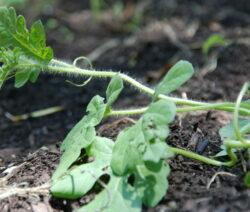

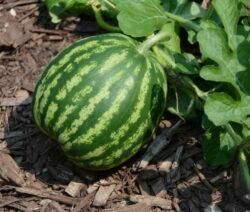
Fertilize watermelons
Watermelons are considered heavy feeders in the garden - a good supply of nutrients is therefore particularly important. Before planting out, it is advisable to work in a primarily organic organic fertilizer like ours Plantura organic tomato fertilizer or compost in the bed. Fertilize again later in the summer.
Harvesting watermelons: when are they ripe?
The ripening time of watermelons is comparatively long - the large fruits are only harvested from the end of August into autumn. For the taste, it is essential to only harvest ripe fruits, because they only develop their sweet taste over time. To tell if a watermelon is ripe, look for these signs:
- Dark green skin with yellow spots
- Dull sound when knocked
- Withering leaves in autumn
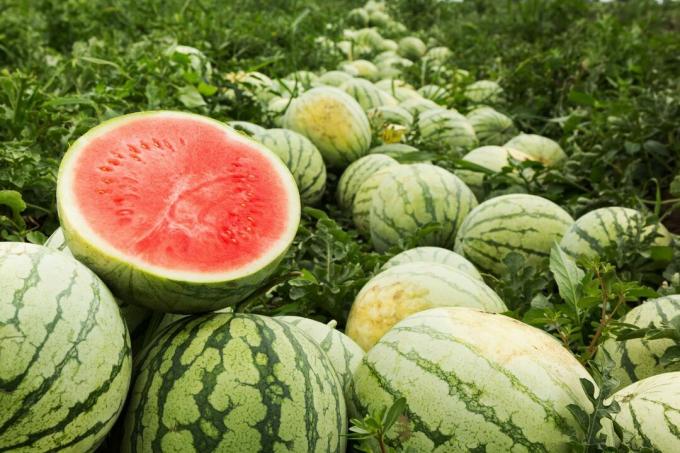
Storing watermelons
Watermelons have a relatively limited shelf life and should ideally be eaten quickly. At room temperature, the exotic fruit can be stored uncut for two weeks without any problems. Unfortunately, as soon as it is cut, its shelf life is shortened very quickly and is therefore best stored in the refrigerator. Freezing watermelons, on the other hand, is not recommended because the fruit is mostly water and becomes mushy after thawing. More to the right Harvesting and storing watermelon you'll find here.
If you're more of a honeydew melon fanatic, check out this article for a guide on how to make it Honeydew melon cultivation.
